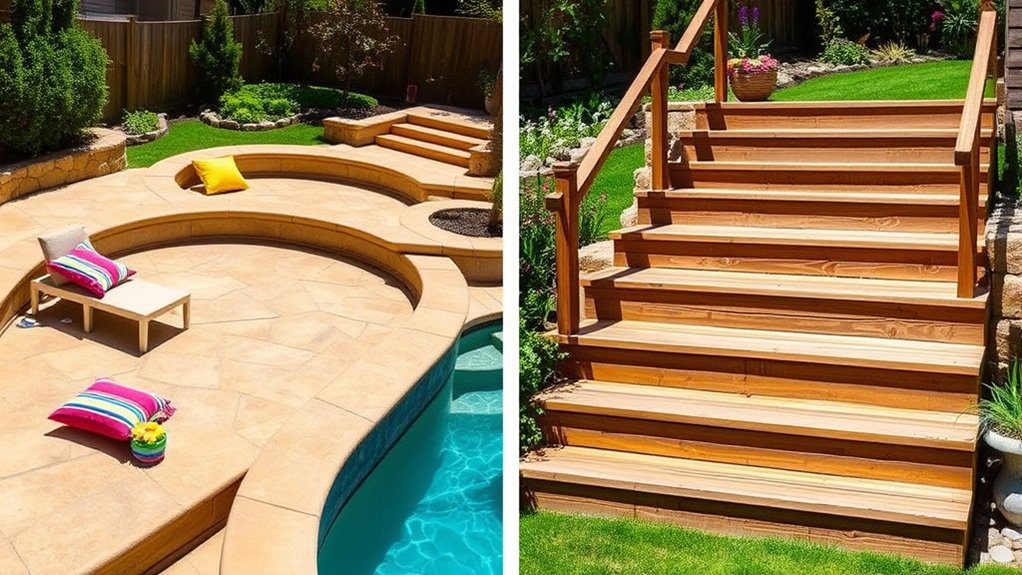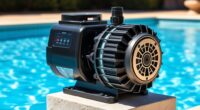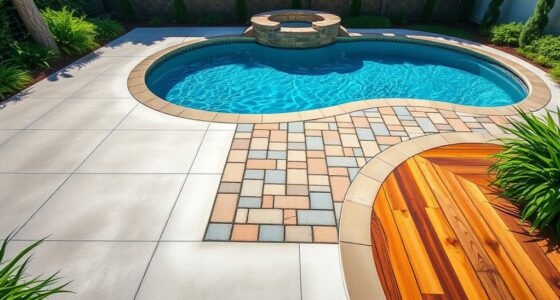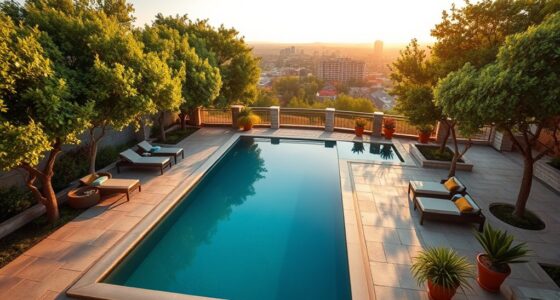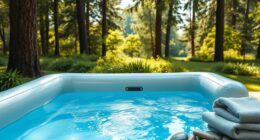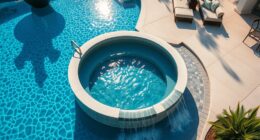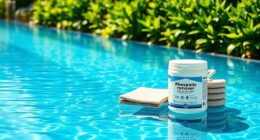If you want a relaxing spot to lounge and enjoy the sun, tanning ledges are a great choice, offering broad, stable surfaces perfect for family fun and comfort. For safer entry and exit, especially with kids, pool steps provide secure, non-slip access and are easier to install and maintain. Consider your space, safety needs, and how your family uses the pool; exploring further will help you find the perfect fit for your backyard.
Key Takeaways
- Tanning ledges offer comfortable lounging and shallow play areas, ideal for families wanting relaxation and socializing.
- Pool steps provide safer, easier entry and exit, especially beneficial for children, seniors, or those with mobility challenges.
- Consider your yard space: ledges require a broad, flat area, while steps fit into existing pool entrances more easily.
- Durability and maintenance needs differ; choose materials that withstand your climate and family activity levels.
- Customization options allow tailoring features to your family’s lifestyle—leisurely lounging or safe, accessible entry.
What Are Tanning Ledges and How Do They Work?
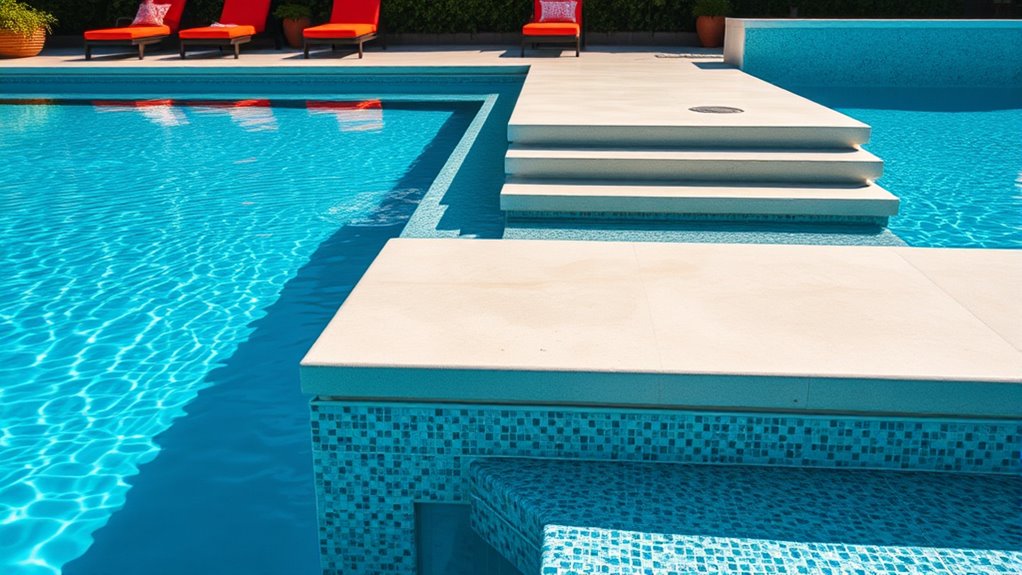
Have you ever wondered how tanning ledges work? These are flat, shallow areas built into your pool, usually about a foot or two deep. They’re designed for lounging and relaxing without fully submerging yourself. When you lie on a tanning ledge, you’re partially in the water, which helps keep you cool and comfortable while catching some sun. The ledge extends along parts of the pool’s perimeter, offering a stable surface for sitting or lying down. Water flows underneath, providing a gentle, soothing current. This shallow zone is perfect for kids, guests who don’t want full immersion, or anyone looking to relax without leaving the pool. Tanning ledges are both practical and luxurious, enhancing your pool experience with comfort and style. Additionally, many pool designs incorporate tanning ledges to maximize relaxation options and aesthetic appeal.
The Design and Functionality of Pool Steps
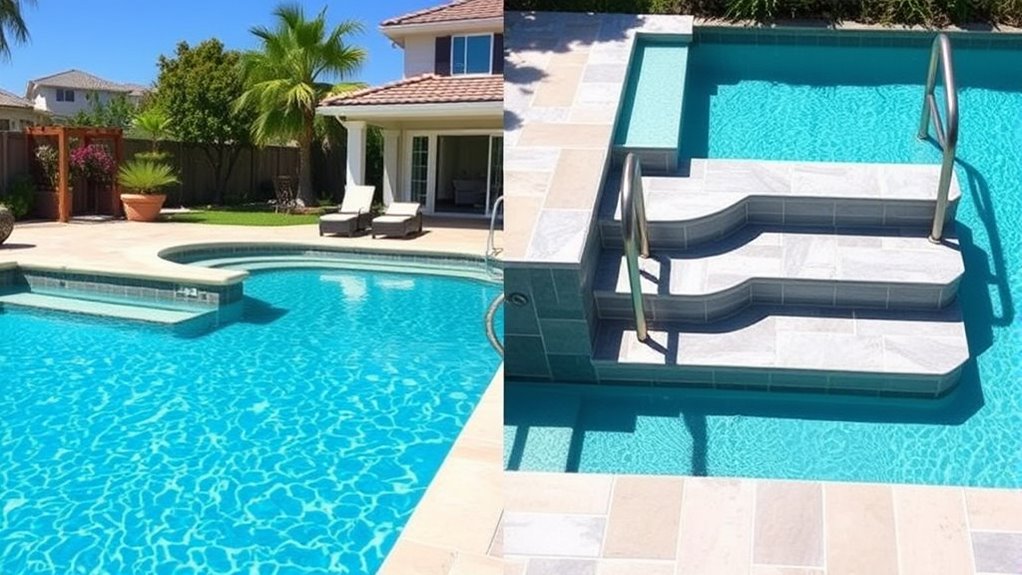
When selecting pool steps, consider the materials used and how durable they are to endure frequent use and weather conditions. Safety features like handrails and non-slip surfaces are essential for easy access and preventing accidents. Understanding these design elements helps guarantee your pool remains both functional and safe. Additionally, choosing sturdy and weather-resistant materials can significantly extend the lifespan of your pool steps.
Step Materials and Durability
The materials chosen for pool steps directly impact their durability and functionality, making them a critical consideration in your overall pool design. You want materials that withstand constant exposure to water, sun, and chemicals without deteriorating. Concrete steps are highly durable and long-lasting but can be slippery if not finished properly. Fiberglass offers strength and a smooth surface, reducing slip risk, and resists corrosion. Composite materials combine durability with low maintenance, resisting mold and algae buildup. Vinyl steps are budget-friendly and easy to install but may not last as long under heavy use. Aluminum steps are lightweight and corrosion-resistant but can be less comfortable to walk on. Selecting high-quality materials ensures your steps remain safe, sturdy, and attractive for years to come.
Accessibility and Safety Features
Ensuring your pool steps are accessible and safe is essential for all users, regardless of age or mobility. Proper safety features help prevent accidents and make entering and exiting the pool easier. To achieve this, consider these key features:
- Non-slip surfaces: Textured treads prevent slips, even when wet, providing firm footing.
- Handrails: Sturdy handrails offer support for stability and balance, especially for seniors or children.
- Gradual incline: Steps with gentle slopes allow for safer, easier entry without sudden drops.
These features work together to create a safer environment, giving you peace of mind while enjoying your pool. Prioritize safety to ensure everyone in your family can swim confidently and comfortably.
Safety Considerations for Families With Children

Families with children should prioritize safety when choosing between tanning ledges and steps. Tanning ledges are generally flat and wide, providing a stable surface for kids to sit or play on, reducing the risk of falling. However, guarantee the ledge has non-slip surfaces and smooth edges to prevent injuries. Additionally, AI-powered safety features like pool alarms and real-time monitoring can further enhance security. Steps can be more challenging for young children to navigate safely, especially if they are steep or lack handrails. If you prefer steps, look for ones with rounded edges, sturdy handrails, and adequate depth to prevent slipping. Always supervise children closely around both options. Installing safety features like pool alarms, fencing, and non-slip mats further enhances safety. Your goal is to choose an option that minimizes risks while allowing your family to enjoy pool time with confidence.
Comfort and Relaxation: Which Option Offers Better Lounging?
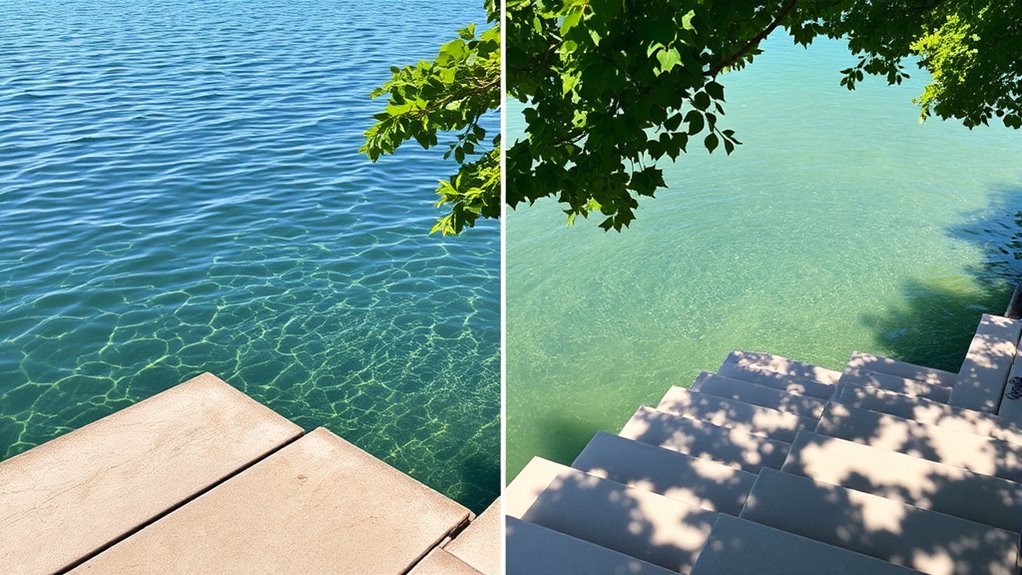
When it comes to relaxing, you’ll notice that tanning ledges often provide a more comfortable lounging experience than steps. They’re designed for easy access and support, making it simpler to settle in and unwind. Consider which option feels better for your relaxation needs as you weigh comfort and accessibility. Additionally, backyard greenhouses are often built with features that can complement your outdoor lounging space, creating a more inviting environment.
Comfort Level Differences
While both tanning ledges and steps are designed to provide a comfortable spot to relax, their comfort levels can differ considerably. Tanning ledges are typically flat, wide, and shallow, making them perfect for lounging and soaking up the sun without much effort. Steps, on the other hand, are usually more structured, with varying heights that may not be as ideal for extended lounging. Additionally, the organization of space in tanning ledges often facilitates better relaxation by creating a designated area for lounging without interruption. Here’s how they compare: 1. Tanning ledges provide a broad, flat surface, letting you stretch out comfortably. 2. Steps can be less forgiving, often requiring adjustment to find the right position. 3. The ledge’s surface usually feels softer and more inviting for long periods of relaxation, while steps may be better for quick dips or sitting upright.
Ease of Access and Use
Ease of access and use play a significant role in determining which lounging option is more practical for relaxing by the pool. Tanning ledges are typically shallow, making it easy to step onto and settle down without much effort. They’re ideal if you want quick, effortless entry and exit, especially for small children or seniors. Steps, on the other hand, require you to climb or descend, which can be less convenient, especially if they’re steep or narrow. However, steps often offer more support and stability, making it easier to get in and out safely. Your choice depends on your mobility and how easily you want to access your lounging spot. Consider your family’s needs for comfort, safety, and ease to decide which option suits your poolside relaxation best. Proper planning can help ensure your pool area is accessible and safe for everyone.
Maintenance and Cleaning of Ledges Vs Steps
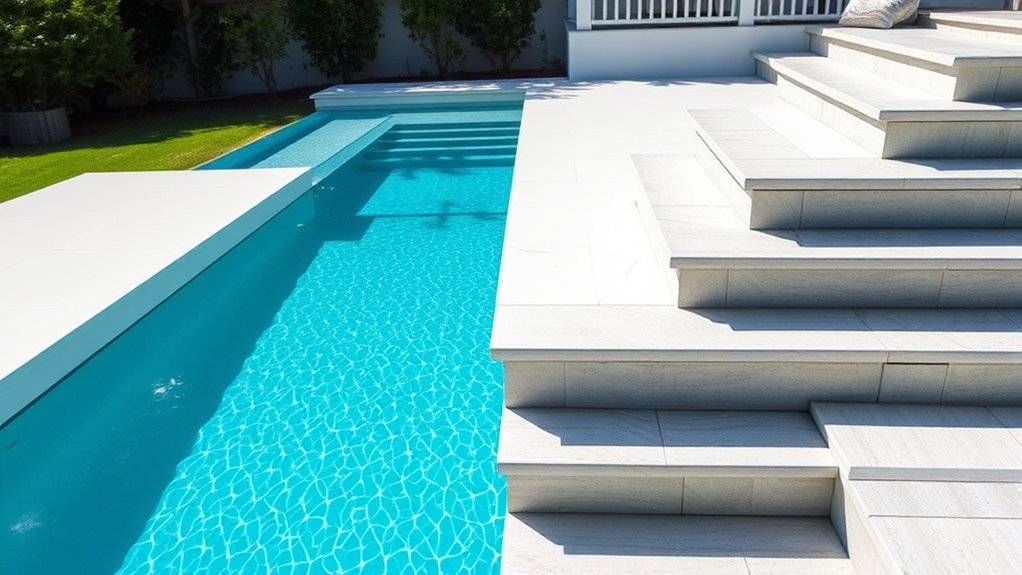
Maintaining and cleaning tanning ledges and steps requires different approaches to guarantee safety and longevity. For ledges, you’ll want to focus on regular brushing and rinsing to prevent buildup of dirt and algae, especially in shaded areas. Steps, on the other hand, need thorough scrubbing and inspection to avoid slipping hazards. Here are three key points:
- Use a gentle brush and mild cleaner to remove grime from ledges without damaging the surface.
- Inspect steps frequently for cracks or loose tiles, fixing issues immediately.
- Keep surfaces dry and free of debris to prevent slipping and maintain aesthetic appeal.
Cost Differences Between Installing Tanning Ledges and Steps
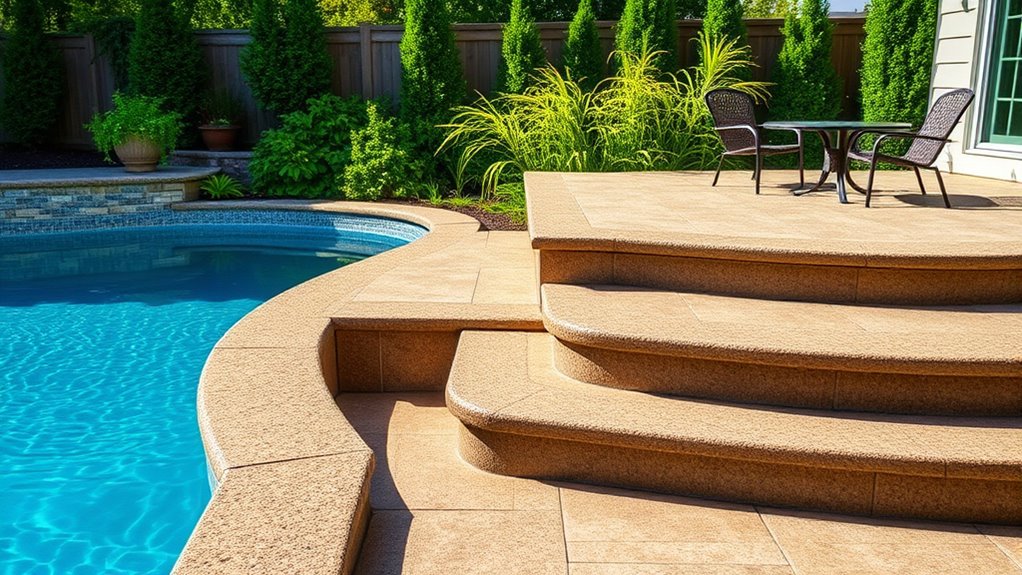
Installing tanning ledges typically costs more upfront than adding steps, primarily because ledges require custom shaping and waterproofing to guarantee durability and safety. The extra investment covers specialized materials and labor to create a seamless, waterproof surface that withstands weather and pool use. In contrast, steps are generally standard, prefabricated components that are easier and quicker to install, reducing labor costs. Additionally, the complexity of a tanning ledge might involve custom design work, increasing overall expenses. While the initial cost is higher for a ledge, it can add value and appeal to your pool area. However, if budget constraints are tight, steps tend to be a more economical choice, with lower installation costs and less customization involved. Proper installation ensures long-term durability and safety, which is especially important for features like tanning ledges.
Space Requirements and Pool Layout Compatibility
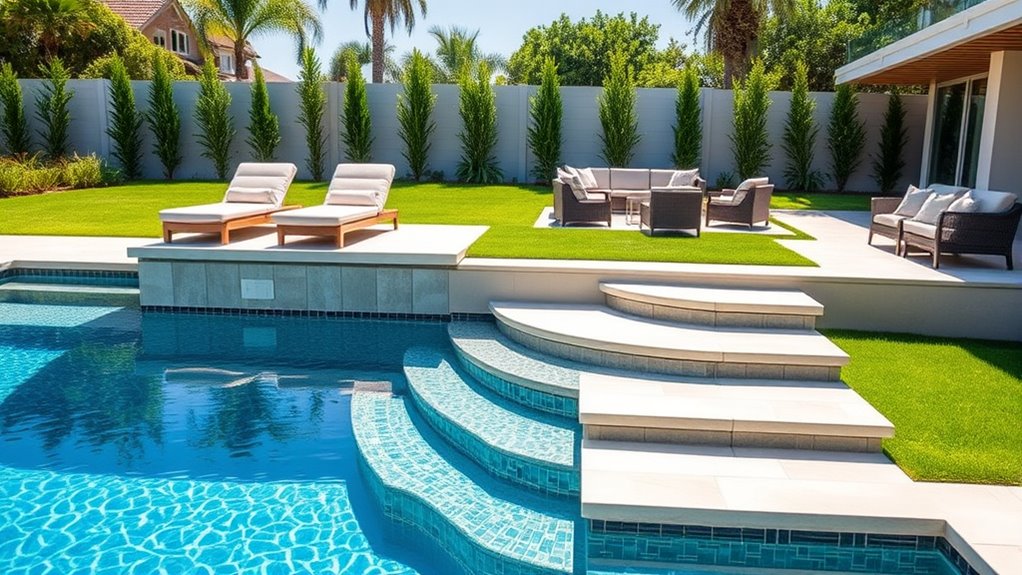
When planning your pool area, the available space and overall layout play a crucial role in deciding between a tanning ledge and steps. Tanning ledges typically require a flat, unobstructed section of pool deck, often about 8-10 feet wide, to comfortably accommodate loungers and ensure safety. Steps, on the other hand, need strategic placement at the pool entrance, fitting into the existing design without taking up excess space. Incorporate rustic decor to enhance the overall aesthetic and create a welcoming environment. Consider these points: 1. A tanning ledge demands a broad, level area for lounging and easy access. 2. Steps need to align with the pool’s shape, fitting seamlessly into corners or entry points. 3. Both features should complement your yard’s size, avoiding overcrowding or awkward configurations.
Customization Options for Both Features
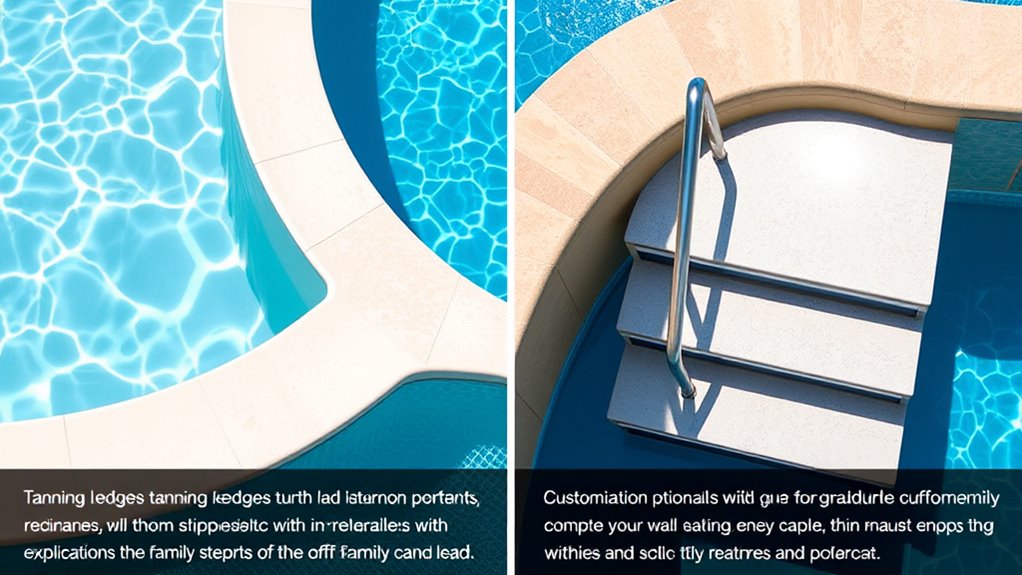
Both tanning ledges and steps offer a variety of customization options to match your style. You can choose from different designs, shapes, and sizes to fit your pool’s look. Additionally, there are numerous material and finish choices to create a personalized, polished appearance.
Design Flexibility Options
Design flexibility plays a crucial role in choosing between tanning ledges and steps, as it allows you to tailor each feature to fit your specific aesthetic and functional preferences. With customization options, you can modify size, shape, and orientation to match your pool’s design seamlessly. Incorporate features like adjustable flow rate to ensure optimal water circulation and comfort. 1. Adjust the width and length of the tanning ledge to create a perfect lounging space or accommodate your kids’ play area. 2. Choose the number and placement of steps to ensure easy entry and exit, matching your preferred flow. 3. Incorporate built-in features like ledge seating or integrated lighting for added convenience and style.
These options give you the freedom to personalize your pool, making it more functional and visually appealing for your family’s needs.
Material and Finish Choices
Material and finish choices substantially impact the look, feel, and durability of your pool features. For tanning ledges, popular options include textured concrete, quartz finishes, or natural stone, offering slip resistance and aesthetic appeal. Steps often feature smooth tiles, fiberglass, or acrylic surfaces, which provide comfort and ease of maintenance. You can choose from a variety of colors and textures to match your outdoor decor. For a sleek, modern look, polished finishes work well, while matte surfaces hide water spots better. Consider the climate and usage when selecting materials—some withstand weather better than others. Durable finishes like epoxy or specialized pool paints protect surfaces against algae and staining. Your choices directly influence your pool’s style, safety, and longevity, so pick options that suit your family’s lifestyle.
Longevity and Durability of Ledges and Steps
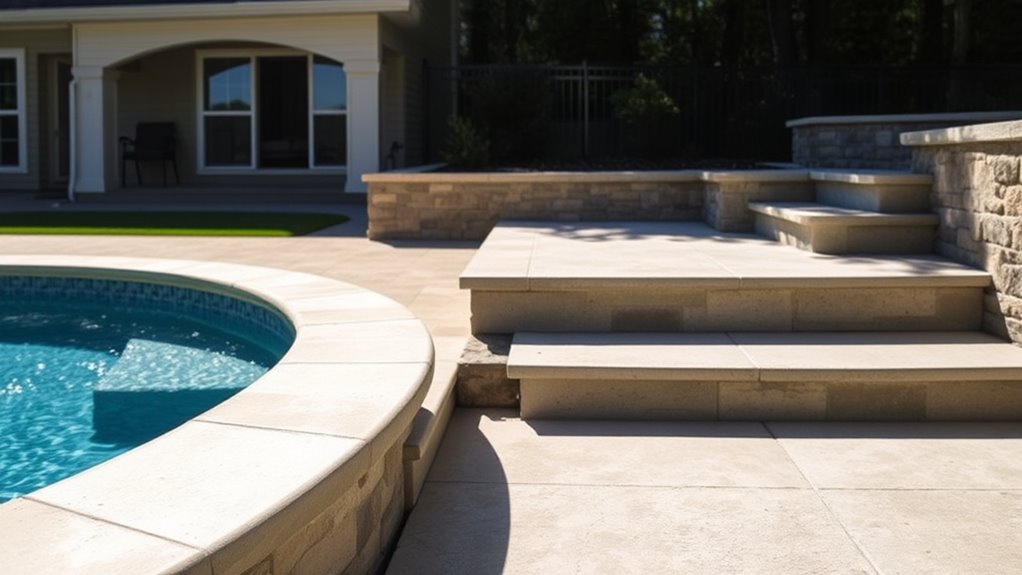
When it comes to longevity and durability, understanding how ledges and steps withstand daily wear is essential. Ledges typically face frequent exposure to sun, water, and foot traffic, which can wear down their surface over time. Steps, especially those made from sturdy materials, tend to handle heavy use better and resist chipping or cracking. To give you a clearer picture:
- Material strength: Solid materials like stone or composite last longer than softer woods.
- Weather resistance: Well-sealed surfaces prevent damage from moisture and UV rays.
- Maintenance needs: Regular upkeep extends the lifespan of both ledges and steps, keeping them looking new longer.
Choosing durable materials and proper maintenance ensures your investment guarantees the test of time.
Making the Right Choice for Your Family’s Needs

Choosing between ledges and steps depends largely on your family’s lifestyle and specific needs. If your kids love lounging and sunbathing, a ledge offers a comfortable, relaxed spot to stretch out. It’s perfect for sunbathers who want easy access and a low-risk area. On the other hand, if your family prefers active use, steps provide safer, more stable access to the pool, making it easier for everyone to enter and exit confidently. Consider your space constraints too—steps can take up more room but offer better support, while ledges create a seamless, integrated look. Think about safety, ease of use, and how your family will enjoy the pool area daily. Making the right choice ensures your pool enhances your family’s fun and safety for years to come.
Frequently Asked Questions
How Do Tanning Ledges Impact Pool Water Circulation?
Tanning ledges can somewhat impact pool water circulation by creating shallow areas where water movement slows down, potentially leading to less effective filtration. However, if your pool’s circulation system is well-designed, it can handle these zones without issue. You might notice minor dead spots, but regular pump operation and strategic skimming help maintain proper water flow. Overall, tanning ledges don’t significantly disrupt circulation if your system is properly balanced.
Are Steps Better for Elderly Family Members’ Mobility?
Yes, steps are generally better for elderly family members’ mobility. They provide stable handrails and a gradual incline, making it easier and safer to enter and exit the pool. Unlike tanning ledges, which require stepping down onto a shallow surface, steps offer support and control. This design minimizes the risk of slips and falls, giving seniors confidence and independence while enjoying the pool.
Can Tanning Ledges Be Used for Underwater Seating?
Yes, tanning ledges can be used for underwater seating, creating a cozy spot to relax while partially submerged. Think of it as a built-in lounge chair underwater, perfect for soaking up the sun without leaving the pool. They’re great for lounging, socializing, or even for kids to sit comfortably while playing. Just guarantee the ledge is sturdy and designed for seating to keep everyone safe and comfortable.
What Are the Safety Hazards Associated With Each Option?
You should be aware that both tanning ledges and steps pose safety hazards. With tanning ledges, there’s a risk of slipping or falling if the surface is wet or algae-covered, especially for children or elderly family members. Steps can also be slippery and may cause trips or falls if not properly maintained or if they’re too steep. Always supervise your family, make certain surfaces are slip-resistant, and consider adding handrails for added safety.
How Do Different Materials Affect the Lifespan of Ledges and Steps?
Different materials substantially impact the lifespan of ledges and steps. For example, concrete and stone are durable and resistant to weather, lasting many years with minimal maintenance. Wood, however, can deteriorate faster, especially if exposed to moisture or sun, leading to cracks or rot. Choosing high-quality materials suited to your environment ensures your ledges and steps remain safe, sturdy, and attractive over time.
Conclusion
Choosing between tanning ledges and steps depends on your family’s needs, but don’t worry—both options can enhance your pool experience. Imagine relaxing effortlessly on a ledge or confidently entering the water via sturdy steps. With proper maintenance, either feature will last for years. So, consider your space, safety, and comfort, and you’ll create a backyard oasis everyone will enjoy. No matter your choice, your perfect pool retreat is just a decision away.
